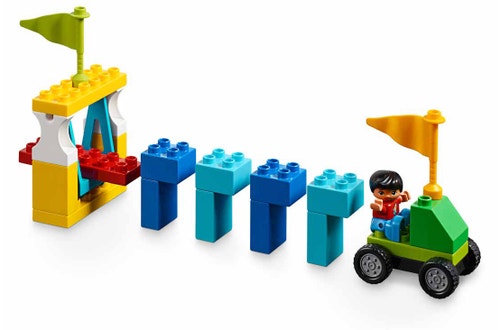Chain Reaction
In this lesson, students will learn about cause and effect by creating chain reactions.

Prepare
Review this lesson plan and choose what you need from the Teacher Support box.
If necessary, pre-teach these related vocabulary words: cause, trigger, effect, chain reaction, sequence of events.
Consider the abilities and backgrounds of all your students and decide when and how to introduce and differentiate lesson content, activities, or concepts.
Connect
- Show the students the inspiration photo and ask them to describe what they see, then tell them that it shows a model of a ride called Free Fall.

Tell the students that you are going to read a story about a boy and a girl who were visiting STEAM Park.
Explain that the story will describe a chain reaction, or a sequence of events that is caused by a trigger.
Read the following story aloud:
Matt and Sienna decided to ride Free Fall, the scariest ride in STEAM Park. They waited in line for only a few minutes and then stepped onto the platform. The machine pulled the rope until they were at the top of the tower.
“Wow! We are way up high!” Matt said.
“I’m so excited to feel my stomach tickle! I wonder when it’s going to drop us,” Sienna said.
They looked at the view of the park as they waited for the fall. Then, the lever holding the rope in place moved and released it. Matt and Sienna screamed and laughed as they dropped. The platform landed on another lever and raised a flag.
“That was the best ride ever!” Sienna said.
“Let’s go again!” Matt said.
Consider asking questions like:
- What caused the platform to drop?
- What happened next?
Explain that the trigger to the sequence of events in the story is that the lever moved and released the rope, which caused the platform to drop. When the platform landed, it caused another event to happen, the raising of the flag. Tell the students that this sequence of events is called a chain reaction.
Construct
Ask the students to work in pairs to create a chain reaction. Remind them that one event should cause another event to happen.
Show them the inspiration photos for this lesson and ask them to think about how they could make an object move without touching it.

- Tell them that they can build separate parts of the chain reaction and then put the model together and test it.
Tip: You can find photos of individual parts of the model in the appendix and assign which part each student or pair of students should build.
Contemplate
Ask the students to share their chain reactions with the rest of the group.
Consider asking questions like:
- What was the first cause or trigger in your chain reaction?
- What was the first event in your chain reaction?
- What was the last event in your chain reaction?
- Did your chain reaction turn out the way you predicted? Why or why not?
Continue
Ask the students to combine their chain reactions to create one long chain reaction.
Assign a place in the classroom where they can assemble the long chain reaction, then ask them to take turns setting it off and making adjustments until it works.
Tip: Have the students draw the chain reaction and number the events.
Did you notice?
- Ask guiding questions to elicit students’ thinking and their decisions while ideating and building: What shapes are you using in your chain reaction? Are they two-dimensional shapes or three-dimensional?
Observation Checklist
Review the learning objectives and success criteria addressed in this lesson (Teacher Support box).
Use the following checklist to observe students’ progress:
- Students' investigation plan includes a way to make observations and collect the data about the strength and directions of pushes and pulls in the chain reaction.
- Students predict the effect of a push or a pull on an object.
- Students can describe the object(s) that will move without being touched in the investigation and what will happen to cause the push or pull.
- Students will use positional words (e.g., above, below, beside, in front of, behind, or next to) when describing the events in the chain reaction.
Teacher Support
Students will:
- Identify cause and effect
- Create their own chain reactions
NGSS K-PS2-1. Plan and conduct an investigation to compare the effects of different strengths or different directions of pushes and pulls on the motion of an object.
Extension:
CCSS.MATH.CONTENT.K.G.A.1 Describe objects in the environment using names of shapes, and describe the relative positions of these objects using terms such as above, below, beside, in front of, behind, and next to.




